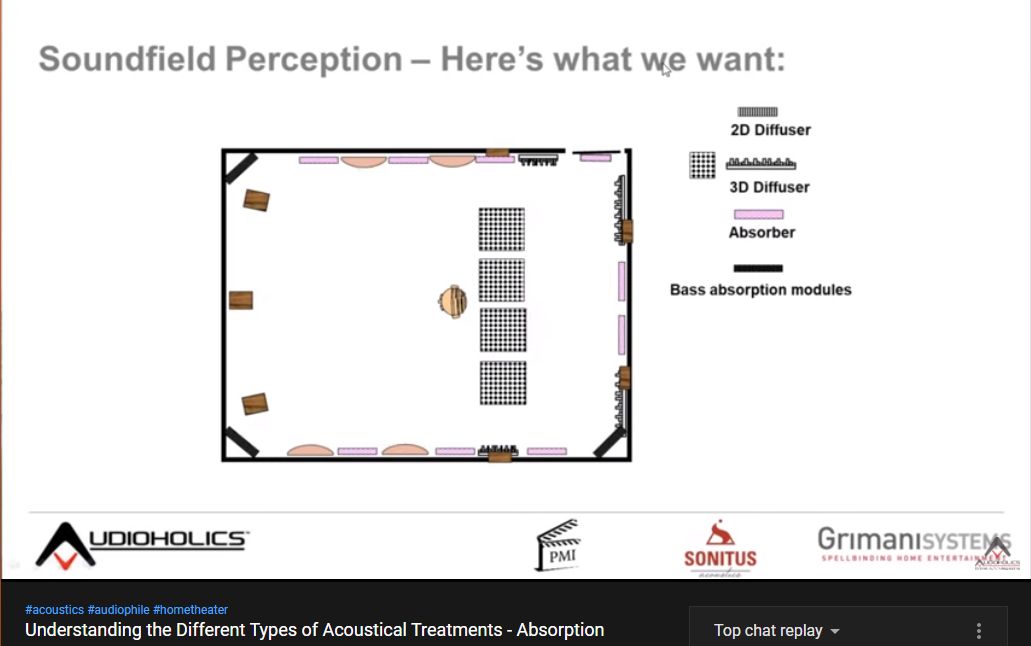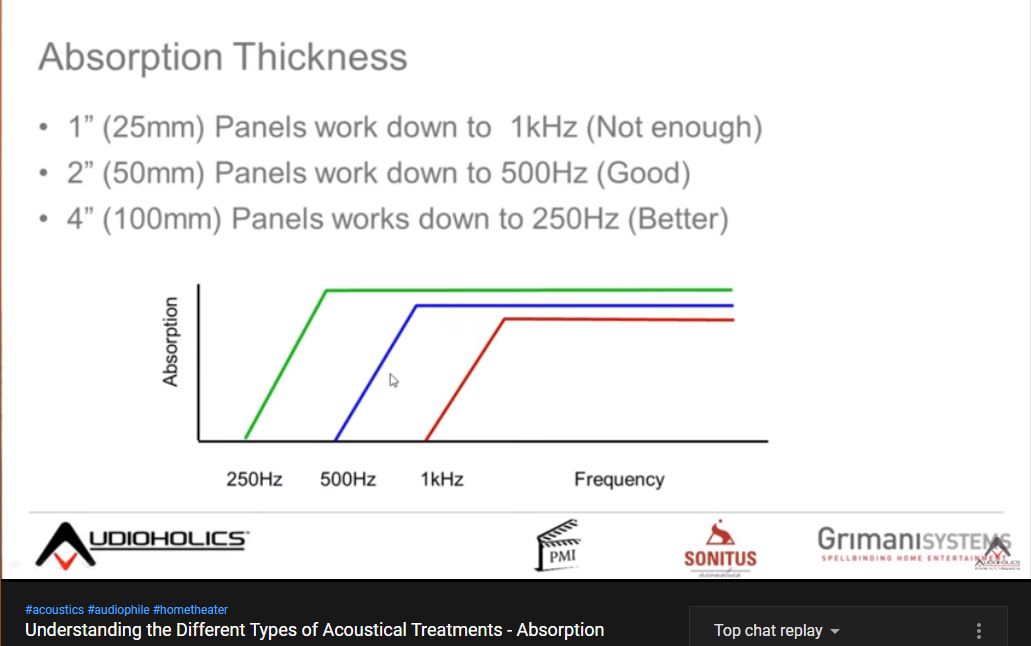Understanding the Different Types of Acoustical Treatments
In this livestream, we go over the various types of acoustical room treatments with resident expert Anthony Grimani. We discuss how to acoustically treat a room and where to locate treatments along with things you should NOT do. Various acoustical treatment types are discussed with this episode focusing on absorption. Diffusion, reflectors, and bass traps and their effectiveness are briefly discussed in this episode but will be expanded upon in future talks.
A “well-treated” room has clear direct sound from speakers, and a nearby, smoothly dispersed field.
Acoustics recipe:
- 15% absorptive surface
- Even distribution
- Lower reflected energy
- 20% Diffusive surface
- 2D in front; 3D in rear (improves spaciousness)
- Bass absorption in corners
- Treat ceiling (veritcal reflections “narrow” the soundfield)
Recommended Cables:
250ft CL2 12AWG Speaker Cable: https://ilnk.org/2/44cac
Locking Banana Plugs: https://ilnk.org/2/3wulo
9ft 4K HDR HDMI Cables: https://ilnk.org/2/1au84
Recommended Electronics:
Denon AVR-X3700H 9.2CH AV Receiver: https://ilnk.org/2/27ozd
Yamaha RX-A3080 9.2CH AV Receiver: https://ilnk.org/2/3fgar
Denon AVR-X6700H 11.2CH AV Receiver: https://ilnk.org/2/4feyr
Recommended Speakers:
SVS Prime 5.1 Speaker / Sub System: https://ilnk.org/2/37pp0
Klipsch RP-8000F Tower Speakers: https://ilnk.org/2/2mvk5
Pioneer SP-FS52 Speakers: https://ilnk.org/2/516ur
Sony SSCS5 Speakers: https://ilnk.org/2/4uc45
SVS SB-3000 13″ Subwoofer: https://ilnk.org/2/43svu
In acoustics, absorption is one of the primary methods used to manage sound within a space. Absorption materials are designed to absorb sound energy, reducing the level of reverberation and minimizing reflections. Here are the different types of acoustical treatments related to absorption:
1. Acoustic Panels: Acoustic panels are one of the most common types of absorption treatments. These panels are typically made from porous materials, such as foam, fiberglass, or mineral wool, that trap sound waves as they pass through. They can be installed on walls, ceilings, or even freestanding as baffles to effectively absorb sound energy across a range of frequencies.
2. Fabric-Wrapped Panels: Fabric-wrapped panels are similar to standard acoustic panels but feature a fabric covering over the absorption material. The fabric covering not only enhances the aesthetic appearance of the panels but also allows for customization with various colors, patterns, and textures. Fabric-wrapped panels are commonly used in theaters, recording studios, and conference rooms.
3. Acoustic Ceiling Tiles: Acoustic ceiling tiles are specifically designed to absorb sound energy and reduce reverberation within a room. These tiles are typically made from mineral fiber or fiberglass and are installed in a grid system suspended from the ceiling. Acoustic ceiling tiles are commonly used in office buildings, schools, and commercial spaces to improve speech intelligibility and reduce noise levels.
4. Bass Traps: Bass traps are absorption devices designed to absorb low-frequency sound waves, which are more challenging to control than mid and high frequencies. Bass traps are typically placed in corners of a room, where low-frequency sound tends to accumulate due to room modes and standing waves. Bass traps can be made from thick absorptive materials, such as fiberglass or foam, or tuned resonant absorbers designed to target specific low frequencies.
5. Diffusers: While diffusers are not technically absorption treatments, they are often used in conjunction with absorption to create a balanced acoustic environment. Diffusers scatter sound waves rather than absorbing them, helping to break up reflections and prevent standing waves. Diffusers can be made from various materials, including wood, plastic, or foam, and are commonly used in recording studios, concert halls, and home theaters.
6. Perforated Panels: Perforated panels are acoustic panels with small holes or perforations that allow sound waves to pass through to the absorption material behind. The perforations are typically arranged in patterns designed to optimize absorption across a range of frequencies while maintaining a decorative appearance. Perforated panels are commonly used in architectural applications, such as auditoriums, restaurants, and lobbies.
Overall, absorption treatments play a crucial role in controlling sound within a space, improving acoustics, and enhancing the listening environment for various applications. By understanding the different types of absorption treatments available, designers and architects can effectively manage sound and create spaces that are both aesthetically pleasing and acoustically functional.
Acoustical treatments, particularly absorption, play a crucial role in managing sound within a space, whether it’s a recording studio, concert hall, office, or home theater. Absorption is one of the primary methods used to control reverberation, echoes, and overall sound quality. Here’s an overview of absorption and its various types:
1. Broadband Absorbers: These absorbers are designed to absorb sound energy across a wide range of frequencies. They are typically made of porous materials like mineral wool, fiberglass, foam, or acoustic fabric. Broadband absorbers are effective at reducing reflections and controlling reverberation in a room.
2. Resonant Absorbers: Resonant absorbers are designed to target specific frequencies or narrow bands of frequencies. They work by exploiting the principle of resonance, where sound energy is absorbed and dissipated by vibrating resonant panels or membranes. Helmholtz resonators and membrane absorbers are common types of resonant absorbers used in acoustical treatments.
3. Panel Absorbers: Panel absorbers consist of rigid panels or slabs of absorptive material mounted on walls or ceilings. They are effective at absorbing mid- to high-frequency sound waves and are often used in recording studios, home theaters, and offices. Panel absorbers can be designed to blend in with the room’s decor or serve as decorative elements themselves.
4. Porous Absorbers: Porous absorbers, also known as porous absorptive materials, are made of materials with open-cell structures, such as foam, mineral wool, or acoustic fabric. These materials trap sound waves as they pass through the porous structure, converting acoustic energy into heat through viscous dissipation. Porous absorbers are effective at absorbing high-frequency sound waves and are commonly used in acoustical treatments for walls, ceilings, and panels.
5. Membrane Absorbers: Membrane absorbers consist of a thin, flexible membrane stretched over an air cavity or behind a rigid backing. When sound waves strike the membrane, it vibrates, causing the air in the cavity to oscillate and dissipate energy. Membrane absorbers are particularly effective at absorbing low-frequency sound waves and are often used in conjunction with other absorptive materials to create broadband absorption.
6. Diffusive Absorbers: While not strictly absorbers, diffusive surfaces are used to scatter sound waves in order to reduce standing waves and flutter echoes. Diffusive surfaces can be made of irregular shapes, such as diffuser panels or arrays, to scatter sound in multiple directions and create a more balanced acoustic environment.
Each type of absorber has its own advantages and limitations, and the choice of absorptive treatment depends on factors such as the desired acoustic performance, the frequency range to be absorbed, aesthetic considerations, and budget constraints. By strategically incorporating absorption into a room’s design, it’s possible to achieve optimal acoustics and create a more pleasant and functional space for listening, recording, or other activities.

